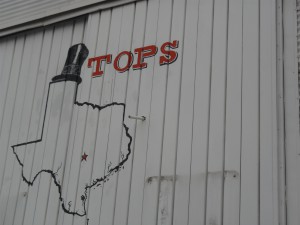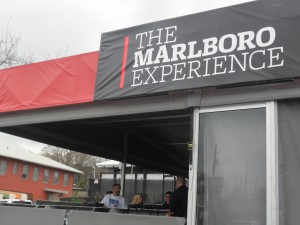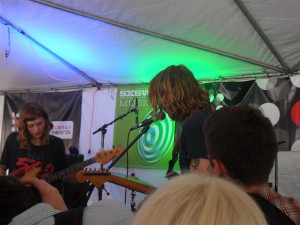South by Southwest (SXSW, or more annoyingly, “South by”) has been on for about a week now, but a change is definitely well underway. For one thing, the packs of 20-somethings roving downtown Austin with the kind of unearned self confidence that comes with a festival badge are significantly more attractive as of yesterday (when bands started to arrive). There has also been a dissipation of the inclusive spirit wrought by bloggers, web editors, venture capitalists, and oracles of the coming reign of social media (more on this in a bit). In its place you can see the more familiar phenomenon of people relishing in their ability to pull rank and manage access to the mindboggling amount of bars and venues in the city.
Yet the film, comedy, and media events making up the first half of SXSW (Interactive Week) and the music portion which will round out the festival is the ubiquity of corporate branding. CNN has refurbished a restaurant near the Convention Center, the primary purpose of which is seemingly to publicize their recent policy of flailing about wildly for any demographic that will shore up their dwindling viewership. Those who allow their festival experience to be dictated by Groupon, Gowilla, and Foursquare are rewarded with free food and alcohol at shifting downtown locations. Chevy Volts and Cruzes will give you a free lift around the city once you’ve acknowledged the fact that these cars were successfully driven down here from Detroit.
The presence of branding, while by all accounts is significantly larger than previous years, is not a troubling or unfamiliar aspect of established festivals like SXSW. Like any festivalgoer I’m more than capable of missing the embedded messages in free food and drinks (I’ve already had to look up the underwriter of today’s Ty Segall show, but I can recount the number of Lone Star’s and contents of the tacos that I had). However, it has taken on a strange form as this year’s festival may be the first in a period of extraordinary exuberance for the possibilities of social media. As Oliver Burkeman observed in his report on SXSW for The Guardian, the language of social media boosters necessarily drifts away from specificity and towards abstraction (or, less generously, outright nonsense) because they promise the fundamental transformation of all aspects of our lives.
I can already see such transformations working on the three levels of desperation fueling any event like this: the corporate desire to establish and sustain meaningful connections with consumers is heightened by making festivalgoers dependent on their beneficence (directing them to and then underwriting parties); the festivalgoer’s desire to gain access to an exclusive space is radically expanded by the effective use of cutting edge social media channels; and finally the gatekeepers of venues and parties are able to manage access in creative ways by engineering how guest lists are compiled. There is no doubt that Interactive Week marks the beginning of significant developments on all three of these levels.
However, there are two ways that we can walk ourselves back from overstating the issue, which comprised a large portion of Interactive Week and is fueling the corporate drive to attach themselves to and brand anything within the city limits this week. The first, noted by Burkeman at the end of his piece, is that the flawed analogy between embodied human experience and potentialities on offer from new sophistications in social media technology is unlikely to be bridged anytime soon. Yet the second, to my mind more compelling response to the hyperbole of social media boosters is the noticeable shift in the character of the city over the past few days. The forms of excess introduced by musicians (and their attractive followers) is unlikely to be replaced by the conveniences of social media anytime soon.
This post may contain affiliate links.












